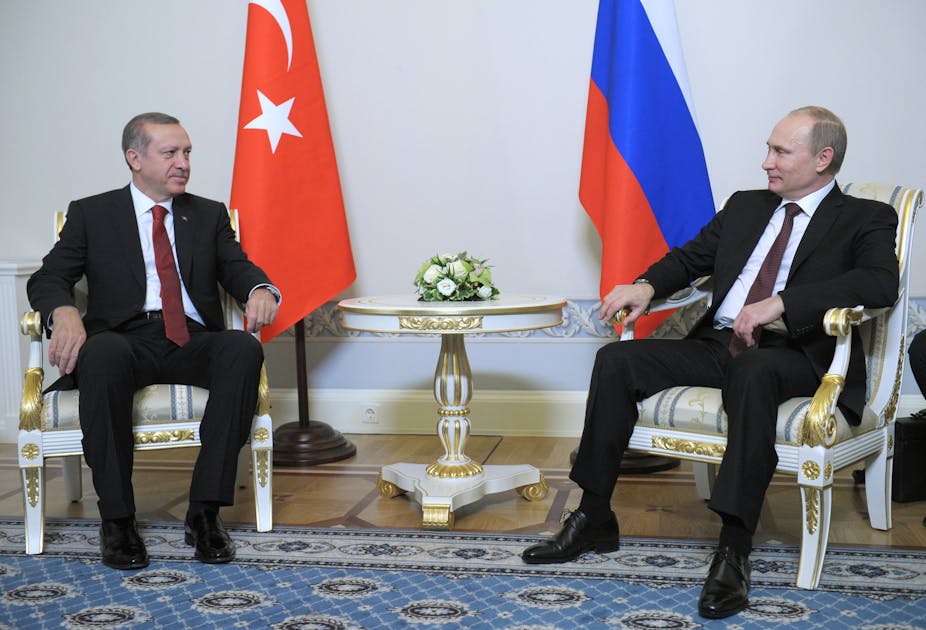In this latest instalment in our series on Russia’s relations with its neighbours, we head south-east to Turkey. The former centre of the Ottoman Empire has been booming in the past decade – and Russia has played a key role in this. But, with regional geopolitics highlighting the differences between the two countries, Turkey specialist Lerna Yanik looks at where relations go from here.
When Vladimir Putin addressed the Turkish-Russian High Level Cooperation Council last November, he had this to say about the two countries’ relations: “We might have our differences on particular issues, but this does not lead to any cooling in our relations. On the contrary, we intensify our contacts and search for common ground.”
This sums up the current state of affairs between the two countries. In particular, Turkey and Russia diverge on how to handle the war in Syria. Turkey envisions a Syria without Bashar al-Assad, while Russia has argued that any foreign intervention to remove him would further destabilise both Syria and the Middle East. Yet this disagreement is overshadowed by booming trade and investment between the two countries and co-operation over energy. The question is whether it will continue.
Old rivals
Both the Ottoman and the Russian empires spent 350 years fighting over territory and influence in their region, ending up in opposing camps during World War I. Despite being very briefly on the same side towards the end of the World War II, the two countries were soon at odds again when the Soviets demanded free access to the Turkish Straits, insinuating that it might otherwise ask that the two countries’ borders be revised.

This turned communism and the USSR into Turkey’s number-one enemy for a number of years. It shaped the country’s security policies, justifying its search for a place in the Western camp. The Soviets officially rowed back after Stalin’s death in 1953, though it took years for relations to improve. Yet by the end of the 1970s Turkey had become one of the top recipients of Soviet aid outside the Warsaw Pact.
Relations chilled again in the 1990s after the collapse of the USSR as the countries clashed over Turkish expansionism in central Asia, the locations of petroleum pipelines and security issues respectively around Chechen and Kurdish separatism. Within a few years, this period passed as Turkey’s limited power for expansion became clear and the two sides compromised on pipelines and security issues.
Energy matters
This awkward phase did not undermine economic ties between the two nations. In 1980 the volume of annual trade between Turkey and the USSR was a mere US$361m (£226m). It rose to $1.5bn in 1992, $20.7bn in 2006 and is currently hovering around $33bn. The number of the Turkish firms investing in Russia is estimated at around 600, producing total investments of around $12bn – compared to $9bn in the other direction. Both Russian and Turkish politicians have repeatedly said they are targeting $100bn by 2023.
A big chunk of the trade volume is taken up by natural gas. Russia supplies almost 60% of Turkey’s natural gas and Turkish demand has tripled since 2000 – greatly increasing the dependency (mostly through the Blue Stream pipeline). The Russians are also building a controversial $20bn nuclear power plant in Akkuyu in southern Turkey.

Yet this increasing dependency on natural gas is rather at odds with Turkish politicians’ desire to turn the country into an energy hub, supplying Europe as a pipeline route for oil and gas from from the likes of Qatar, Iraq and Iran. This would potentially undermine Russia’s European energy dominance, which has forced Turkey into a delicate balancing act.
Russia is meanwhile working on the South Stream pipeline project, a pipeline from southern Russia through Bulgaria and the Balkans to Italy, which will create an alternative to the existing line that goes through Ukraine. Turkey gave lukewarm support for the project, clearly not wishing to antagonise the Russians on this front.
Ukraine and Syria
Turkey has also had to be careful over Ukraine. When Russian annexation of Crimea was followed by pro-Russian rebellion in Donetsk and Luhansk, Turkey equivocally said that Ukraine’s territorial integrity should be respected, but that the government should reform itself to respect the rights of the minorities in Ukraine. When Russia responded to some Western countries’ sanctions by banning their food exports, Turkey and some Latin American countries volunteered to increase food exports to Russia instead, effectively trying to benefit from the situation.
Then there is Syria. The Assad regime has been one of the key clients of the USSR and Russia in the Middle East. But Turkey disowned Syria following the Arab Spring in 2010. Since then it has reiterated its desire for an Assad-free Syria, recently calling on the US to attack Assad as a condition of Turkish support in the battle with Isis.
Several incidents have further heightened Turkish-Russian tensions since the Syrian war began in 2011. In 2012 Turkey forced a Syrian plane carrying dual-use equipment from Russia to Syria to land in Turkey for inspection – a move that angered Moscow and led to a visit by Putin to Turkey being postponed.

Moves by Turkey and NATO last year to create a missile shield and deploy Patriot missiles in the east of the country have also disturbed Russia. Turkey insisted both the missiles and shield were for defensive purposes against Syria. This did little to reassure the Russians, but the matter has never yet come to a head.
For the time being Syria, as Turkey’s ambassador to Moscow has insisted, is “some partial disagreement that don’t even qualify as a difference.” If and when this changes, no doubt the Russians will let Turkey know, possible making life difficult for Turkish businessmen. That should give Russia substantial leverage over its neighbour if the situation came about.
To read previous instalments from our Russia’s borders series, click here.

